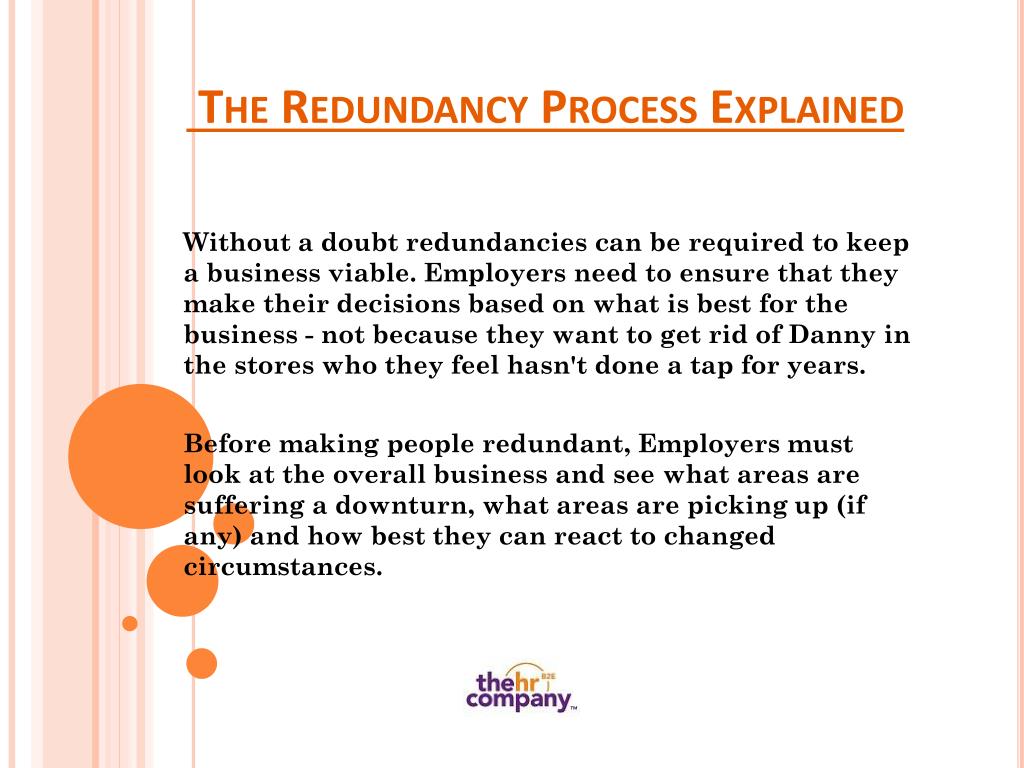Navigating the Legal and Ethical Dimensions of Firm Redundancy: Best Practices for Employers
In the world of business decision-making, the procedure of applying company redundancy can be an intricate journey for employers to navigate. It calls for a fragile equilibrium between legal compliance and honest factors to consider to guarantee the health of both business and its employees. As the landscape of workforce characteristics proceeds to evolve, comprehending the very best techniques in handling redundancies is critical for employers aiming to copyright their obligations while safeguarding their business honesty.
Legal Considerations for Redundancy
Lawful considerations for redundancy have to be carefully navigated by companies to ensure compliance with appropriate legislations and laws. When implementing redundancies, it is vital for companies to abide by the lawful structure established by labor regulations to safeguard the rights of workers. One crucial facet to take into consideration is making certain that the option criteria for redundancy are reasonable, non-discriminatory, and based upon legit business factors.
Employers should also supply appropriate notification to workers who are at risk of redundancy as mandated by regulation. This includes educating staff members of the reasons for redundancy, the selection process, and any entitlements they may have, such as redundancy pay or different employment options. Failure to follow notice needs can cause legal consequences for the firm.

Honest Guidelines in Workforce Decrease
Considering the intricacy of firm redundancies from both a moral and lawful standpoint, ethical guidelines play a crucial role in guaranteeing reasonable and liable techniques throughout labor force reduction processes. It is necessary for companies to communicate freely and truthfully with employees about the reasons for the redundancy, the standards made use of for option, and the support available to those impacted. Respecting the dignity of employees includes carrying out the redundancy procedure in a way that upholds their legal rights, protects their self-respect, and decreases the negative impact on their well-being.
Staff Member Communication Methods
Effective interaction with staff members is critical during labor force decrease processes to ensure assistance, transparency, and understanding. Companies should focus on sincerity and clarity when supplying information of redundancies to their team. Communication methods should be well-balanced and organized carefully to decrease confusion and stress and anxiety amongst workers.
One trick facet of efficient interaction is timing. Companies should notify employees as quickly as decisions concerning redundancies are wrapped up to prevent rumors and conjecture. Supplying clear factors for the labor force reduction and describing the standards made use of in the choice process can help employees comprehend the circumstance better.

Retraining and Redeployment Programs
Throughout the process of labor force reduction, carrying out re-training and redeployment programs can provide workers alternative opportunities for skill growth and career innovation within the organization. These programs are crucial components of a liable redundancy technique that focuses on staff member health and retention. Re-training campaigns offer staff members with the possibility to acquire new skills or enhance existing ones, increasing their worth to the company. By purchasing re-training, organizations demonstrate a dedication to sustaining their labor force via transitions and changes in business environment.
Redeployment programs, on the various other hand, emphasis on matching workers whose roles are at risk of redundancy with offered placements within the firm. Via effective redeployment techniques, employers can alleviate the possible legal risks linked with redundancies, such as unfair termination claims.
Post-Redundancy Assistance Efforts
In the consequences of company redundancy processes, implementing thorough post-redundancy support campaigns is essential to helping influenced workers in their shift to new job opportunities. These efforts can consist of profession counseling, resume writing workshops, task search help, and accessibility to training programs. By providing these assistance solutions, employers show a dedication to their workers' well-being beyond the redundancy occasion.

In addition, creating networking opportunities for redundant employees can be advantageous. notice to employees when closing business uk Linking them with market specialists, holding task fairs, or arranging graduates occasions can increase their job search network and enhance their possibilities of finding new employment. Eventually, investing in post-redundancy support efforts not just profits the affected workers yet also improves the employer's credibility and strengthens worker commitment.
Final Thought
In final thought, companies have to thoroughly browse the lawful and moral measurements of business redundancy to ensure conformity with laws and keep moral requirements. By executing clear communication strategies, retraining and redeployment programs, and post-redundancy support campaigns, employers can mitigate the unfavorable effect of labor force reduction on employees. It is essential for companies to focus on transparency, justness, and compassion throughout the redundancy process to maintain their business values and preserve their online reputation.
When implementing redundancies, it is critical for employers to stick to the lawful framework established by labor legislations to shield the rights of employees.Employers should also offer correct notice to workers that are at threat of redundancy as mandated by law. It is vital for employers to interact honestly and truthfully with workers concerning the factors for the redundancy, the standards used for choice, and the support offered to those affected. Companies need to notify staff members as soon as choices relating to redundancies are settled to avoid reports and conjecture. By offering these support solutions, companies show a commitment to their workers' wellness past the redundancy occasion.
 Josh Saviano Then & Now!
Josh Saviano Then & Now! Mason Gamble Then & Now!
Mason Gamble Then & Now! Michael J. Fox Then & Now!
Michael J. Fox Then & Now! Elin Nordegren Then & Now!
Elin Nordegren Then & Now! Susan Dey Then & Now!
Susan Dey Then & Now!